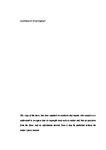Subject and Aesthetic Interface - an inquiry into transformed subjectivities
| dc.contributor.supervisor | Ascott, Roy | |
| dc.contributor.author | Johansson, Kathrine Elizabeth Lorena | |
| dc.contributor.other | School of Art, Design and Architecture | en_US |
| dc.date.accessioned | 2015-04-08T09:07:56Z | |
| dc.date.available | 2015-04-08T09:07:56Z | |
| dc.date.issued | 2015 | |
| dc.identifier | 10227801 | en_US |
| dc.identifier.uri | http://hdl.handle.net/10026.1/3291 | |
| dc.description.abstract |
The present PhD-thesis seeks new definitions of human subjectivity in an age of technoscience and a networked, globalized, Information Society. The perspective presented relates to Philosophy of Science, which includes the Human, the Natural, the Social and the Life Sciences. The project is directed at addressing, and aims to participate in, the further development of Philosophy of Science, or rather, the philosophy of knowing, which leaves a perspective broader than that of science. Methodologically, I combine readings of technoetic artworks, which I approach from a hermeneutical-semiotic perspective, with transdisciplinary research into existing theory concerning the human subject. These readings form my case studies. I keep a particular focus on holistic biophysics (Mae Wan Ho, James Oschman, Marko Bischof). Furthermore, Søren Brier's cybersemiotic theory of communication, cognition and consciousness, which combines a cybernetic-autopoietic and a Peircean semiotic perspective, plays a central role in the project. The project has three parts. Part one contextualizes the study within philosophy of science. It discusses relevant epistemologies, and places the case studies in an art categorical context. It further discusses the philosophical problems involved in writing an academic thesis in the form of a linear, argumentative, critical style, and how it affects the process of meaning making in a way that has consequences to my research. The second part consists of four case studies, each under an overall theme, which applies to the question of human subjectivity. Here I build the concept Extended Sentience, and the concept of an Ideal User. The Ideal User functions as a conceptual frame, which allows me to gradually add more elements to a theory of an altered human subject and knower. The third part presents new ontologies under three basic themes: Time and Relativity, The Life Cycles of Metaphors, and Logos Philosophy and Virtual Grids. These ontologies strongly affect ways of interpretation made in part one and two. Part Three allows more space to my subjective thought processes, which will take precedence over the literature applied. Thus, I, as a post-objective subject observer, will become more transparent. Finally, I will seek an overall conclusion to the project, which should clarify areas where it is evident that the human subject must be reconsidered at a pre-scientific level. It is my thesis that the foundation for human knowledge generation is changing drastically today, and that it has become crucial to reconsider a common understanding of what constitutes the human knower. | en_US |
| dc.language.iso | en | en_US |
| dc.publisher | Plymouth University | en_US |
| dc.subject | Technoetics | en_US |
| dc.subject | Cybersemiotics | |
| dc.subject | Biosemiotics | |
| dc.subject | Technology assisted arts | |
| dc.subject | Subjectivity | |
| dc.subject | Consciousness | |
| dc.subject | Knowledge | |
| dc.subject | Philosophy | |
| dc.title | Subject and Aesthetic Interface - an inquiry into transformed subjectivities | en_US |
| dc.type | Thesis | en_US |
| plymouth.version | Full version | en_US |
| dc.identifier.doi | http://dx.doi.org/10.24382/1284 | |
| dc.identifier.doi | http://dx.doi.org/10.24382/1284 |
Files in this item
This item appears in the following Collection(s)
-
01 Research Theses Main Collection
Research Theses Main


